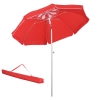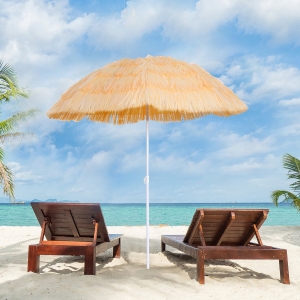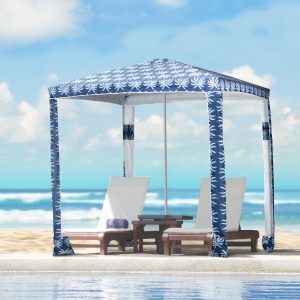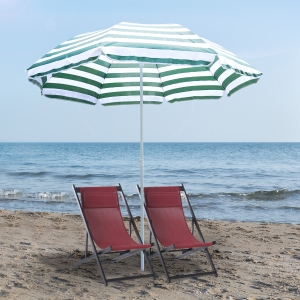Beach Umbrellas
- Popularity
- Price(high to low)
- Price(low to high)
- Greatest Discount
- Date Added (Newest to Oldest)
Beach Umbrellas
How to Choose and Maintain Beach Umbrellas
If you are thinking about going to the beach this summer, then you might want to consider using beach umbrellas. Beach umbrellas can be a great way to spend your time at the beach and can also protect you from harmful UV rays. But before you buy one, it's important to understand how to choose the right type and how to maintain it.
Benefits of Using Beach Umbrellas
Beach umbrellas are a great way to stay in the sun without burning. They're lightweight and easy to carry. Plus, they come with SPF protection. These are also perfect for parents.
The best beach umbrellas offer shade in the form of a top-vent design. This is the most effective type of protection. A good quality fabric will also protect against UVA and UVB rays, which are known to cause skin aging and eye damage.
A beach umbrella with a built-in anchor is a convenient way to keep the sun off. Some of the newer models have a built-in anchor that's designed to last for years. It requires a little work to set it up, but it's worth it.
There are many different kinds of beach umbrellas. Some are light, while others are large. Many are portable and can be easily taken on trips or stored away during the winter.
Most of the umbrellas are made with durable materials that are resistant to sand, water, and rust. Also, most are very easy to set up.
For quick setup, consider an umbrella with a sand anchor. These are available in stores. Usually, a sand anchor comes with a carrying bag.
Alternatively, you can use a sandbag anchor, which you can easily make yourself. You can stack these around the base of your umbrella for a more natural looking look.
Types of Beach Umbrellas
There are a variety of beach umbrellas available in the market. It is important to choose a good beach umbrella that will provide the right shade and comfort for you. The quality of the beach umbrella will depend on the materials used to make it.
Some of the best beach umbrellas are made from aluminum and steel. These are light-weight, durable, and easy to carry. They also have the feature of tilting, so that you can adjust your shade.
Another feature that you can look for in a beach umbrella is UV protection. This will help prevent you from getting sunburn. However, you should make sure that you select a quality fabric. Cotton and polyester are not great for this purpose.
Aside from durability, you should also consider how easy it is to set up. Some beach umbrellas are made with collapsible poles, which are perfect for traveling. Others are wheeled, which makes them portable.
You should also choose a beach umbrella that has a high UPF rating. This will protect you from UVA and UVB rays. Also, make sure that the fabric is quick to dry.
If you are buying for a child, look for beach umbrellas that have kids-sized models. These are often smaller than regular beach umbrellas.
Lastly, you should find a beach umbrella that has a sturdy anchor. An anchor can help you bury your umbrella in the sand.
How to Choose the Right Beach Umbrella
There are a lot of factors you need to consider when choosing a beach umbrella. You need to take into account size, type, and portability. It's also important to choose an umbrella that has features to help you with your sun exposure.
Some features to look for in a beach umbrella include UV protection, a built-in anchor, and a sand anchor. An umbrella with a sand anchor will be able to withstand more wind than an ordinary umbrella.
An umbrella that has an air vent is another great feature. This will allow for a smooth flow of air and alleviate pressure on the canopy.
If you are worried about the potential for an umbrella to float away, you can purchase a carry-on case that will keep your beach umbrella safe. For added convenience, you can also purchase a detachable pole that allows for easy portability.
A beach umbrella's portability might be its most obvious feature. You can easily remove the pole from the canopy to stow the item in your car. Also, most umbrellas come with a carrying bag for easy transportation.
The first thing you need to do is determine the right size for your needs. Choosing a beach umbrella with a diameter of at least six feet will be the best choice. However, you should consider how many people will be using the item. Ideally, a solo umbrella will be able to cover two people comfortably.
How to maintain the beach umbrella
Beach umbrellas are essential to any visit to the beach. They provide privacy, shade, and sun protection. However, they can be dangerous if left unattended. You should know how to maintain the beach umbrella to avoid putting yourself and others in danger.
The first step to maintaining your beach umbrella is to find a flat, dry area. If the sand is too wet, the umbrella will be more likely to fly away.
Another important step is to make sure the base of your beach umbrella is clean. Too much water can warp the base and cause it to crack. Leaving a wet base will also increase the force needed to keep the pole in place.
When you are ready to set up your umbrella, make sure you select the right type for your needs. Polyester is an excellent choice. It is easy to wash, durable, and mold resistant.
Next, you'll want to choose a beach umbrella anchor. There are many options, but the sand anchor is the most common. This anchor will work as a tent stake and will keep your umbrella in place.
After you've anchored the umbrella, you can adjust it for wind. Keep in mind that the wind direction will change as the day goes on.
You'll need to set up your umbrella so that it's facing the wind. By doing this, you'll be able to drive the umbrella deeper into the sand.
Can UV rays go through a beach umbrella?
A beach umbrella can block a portion of the UV rays from the sun. However, studies show that it can't protect against all of them. It's best to use sunscreen and wear sun protective clothing.
There are many different types of umbrellas, and some can be better for protecting you from the UV than others. Some umbrellas, for instance, are made of heavy and opaque fabric, which can prevent more UV rays from reaching your skin than sheer, lightweight fabrics. In addition, some materials are specially designed to provide more protection.
Using an umbrella is a popular way to avoid exposure to direct sunlight. Many people think they're protecting themselves from UV rays when they sit under a shade, but that isn't true.
In a study conducted by researchers from the University of Valencia, they measured the UV rays that were reflected off sand and surfaces. They also tested the UV rays that penetrated the shade of an umbrella. The results showed that only a third of the rays from the sun actually went through.
Researchers used a shadowband to measure the amount of diffuse UV radiation that passed through the shade of the umbrella. This was then measured by a light sensor in the middle of the umbrella.
Beach umbrellas do not provide total protection against UVB rays, and they're not recommended as a replacement for sunscreen. Instead, experts suggest using them as a parallel form of protection.
Why are beach umbrellas not flat?
There is a reason why beach umbrellas are not flat. They are designed to withstand strong winds. However, this also means they are more prone to inverting. To make sure your umbrella stays up and upright, you need to know how to anchor it properly.
Umbrellas are typically made of polyester. This material is durable and UV-treated. It also won't fade if exposed to excessive sun.
If you are unsure how to anchor your beach umbrella, you can use a sand anchor. These can be bought separately or you can buy an umbrella that comes with a built-in anchor. You need to pay attention to the wind direction when setting up your beach umbrella.
Beach umbrellas come in bright colors. However, they may not match your patio furniture. In addition, they tend to heat up due to constant exposure to the sun. For this reason, you should close your umbrella before leaving.
Another reason why beach umbrellas aren't flat is because they are fragile. Some beach umbrellas are flimsy plastic. A good beach umbrella can help you stay cool and relaxed while you're at the beach. While you can't depend on your umbrella to withstand the elements, you can prevent injuries by keeping it in place.
Although it may be tempting to stab your umbrella into the sand, a better choice is to use a sand anchor. A sand anchor can keep your umbrella from inverting.



























































